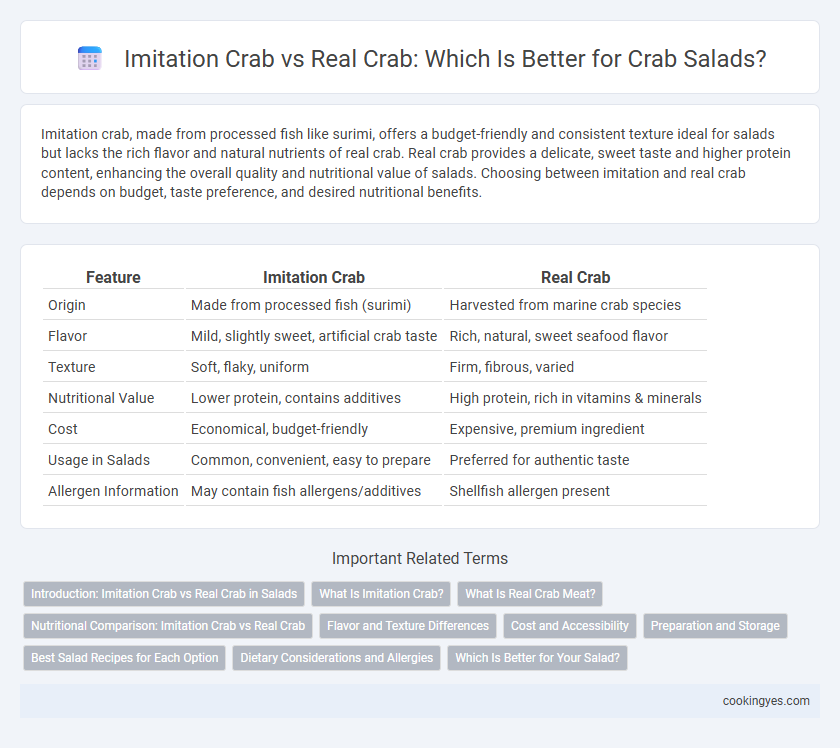Imitation crab, made from processed fish like surimi, offers a budget-friendly and consistent texture ideal for salads but lacks the rich flavor and natural nutrients of real crab. Real crab provides a delicate, sweet taste and higher protein content, enhancing the overall quality and nutritional value of salads. Choosing between imitation and real crab depends on budget, taste preference, and desired nutritional benefits.
Table of Comparison
| Feature | Imitation Crab | Real Crab |
|---|---|---|
| Origin | Made from processed fish (surimi) | Harvested from marine crab species |
| Flavor | Mild, slightly sweet, artificial crab taste | Rich, natural, sweet seafood flavor |
| Texture | Soft, flaky, uniform | Firm, fibrous, varied |
| Nutritional Value | Lower protein, contains additives | High protein, rich in vitamins & minerals |
| Cost | Economical, budget-friendly | Expensive, premium ingredient |
| Usage in Salads | Common, convenient, easy to prepare | Preferred for authentic taste |
| Allergen Information | May contain fish allergens/additives | Shellfish allergen present |
Introduction: Imitation Crab vs Real Crab in Salads
Imitation crab, made from processed white fish like surimi, offers a budget-friendly and consistent texture for salads compared to real crab, which provides rich, natural flavor and higher protein content. Real crab contains essential nutrients such as omega-3 fatty acids and vitamin B12, enhancing the nutritional value of salads. Choosing between imitation crab and real crab hinges on desired taste, nutritional benefits, and cost considerations in salad recipes.
What Is Imitation Crab?
Imitation crab, also known as surimi, is a processed seafood product made primarily from white fish, such as pollock, that is finely minced and flavored to resemble the taste and texture of real crab meat. It is often used in salads as a cost-effective alternative, offering a consistent texture and mild flavor while lacking the natural sweetness and delicate texture of genuine crab. Nutritionally, imitation crab contains fewer proteins and omega-3 fatty acids compared to real crab, which is prized for its rich nutrient profile and distinctive flavor.
What Is Real Crab Meat?
Real crab meat is harvested directly from cooked or steamed crabs, offering a naturally sweet, delicate flavor and flaky texture prized in seafood dishes. It contains high-quality protein, omega-3 fatty acids, and essential minerals like zinc and selenium, contributing to a nutritious salad topping. Unlike imitation crab, which is made from processed fish paste and additives, real crab meat provides authentic taste and a richer nutritional profile, enhancing the overall salad experience.
Nutritional Comparison: Imitation Crab vs Real Crab
Imitation crab contains fewer calories and less protein than real crab, offering about 9 grams of protein per 3-ounce serving compared to real crab's 17 grams. Real crab provides higher amounts of essential nutrients such as omega-3 fatty acids, vitamin B12, and zinc, which support heart health and immune function. Imitation crab is lower in fat and cholesterol but often includes added sugars and sodium, making real crab a more nutrient-dense choice for salads.
Flavor and Texture Differences
Imitation crab, often made from white fish like pollock, has a mild, slightly sweet flavor and a firm, rubbery texture that mimics real crab meat but lacks its rich, briny taste. Real crab offers a naturally sweet and delicate flavor with a tender yet slightly fibrous texture, providing a more authentic seafood experience. In salads, real crab enhances the dish with complex oceanic notes and a satisfying mouthfeel, while imitation crab delivers consistent texture and affordability but falls short in genuine crab flavor depth.
Cost and Accessibility
Imitation crab offers a budget-friendly alternative to real crab, costing significantly less per pound and making it accessible for consumers on a tight budget. It is widely available in most grocery stores year-round, unlike real crab, which can be seasonal and more expensive due to fishing and processing costs. Choosing imitation crab enhances salad affordability and convenience while maintaining a crab-like flavor and texture.
Preparation and Storage
Imitation crab, made from processed white fish like surimi, requires minimal preparation and can be used directly from the package in salads, making it convenient for quick meals. Real crab demands more preparation, including cooking, shell removal, and careful handling to preserve its delicate texture and flavor. For storage, imitation crab should be kept refrigerated and consumed within a few days, while cooked real crab can be stored in an airtight container in the fridge for up to three days to maintain freshness and prevent spoilage.
Best Salad Recipes for Each Option
Imitation crab, made from surimi, offers a budget-friendly and mild-flavored option ideal for creamy seafood salads like California crab salad or spicy crab corn salad. Real crab, prized for its sweet, delicate taste and flaky texture, shines in fresh, simple recipes such as crab Louie or classic crab and avocado salad that highlight its natural flavor. Choosing between imitation and real crab depends on the desired salad complexity, budget, and authentic seafood experience.
Dietary Considerations and Allergies
Imitation crab contains processed fish proteins and additives, making it a lower-calorie, less expensive option for salads but often high in sodium and lacking essential nutrients found in real crab. Real crab offers rich sources of omega-3 fatty acids, vitamins B12 and zinc, supporting heart health and immunity but poses allergy risks for shellfish-sensitive individuals. Selecting between imitation and real crab requires careful attention to ingredient labels and allergy warnings to avoid adverse reactions.
Which Is Better for Your Salad?
Real crab offers superior flavor and a richer nutritional profile for salads, providing higher protein and essential omega-3 fatty acids compared to imitation crab. Imitation crab, made from processed fish like pollock and additives, is lower in calories and cost but less nutrient-dense. For a salad prioritizing taste and health benefits, real crab is the better choice.
Imitation Crab vs Real Crab for salads Infographic

 cookingyes.com
cookingyes.com